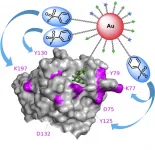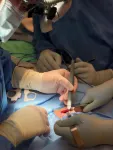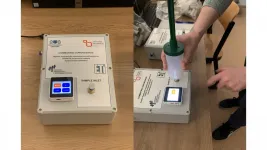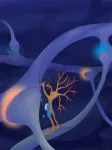Face off for best ID checkers
The Glasgow Face Matching Test has been updated to find super-recognisers who can help prevent errors caused by face recognition software.
2021-07-06
(Press-News.org) Psychologists from UNSW Sydney have developed a new face identification ability test that will help find facial recognition experts for a variety of police and government agencies, including contract tracing.
The Glasgow Face Matching Test 2 [GFMT2] targets high-performing facial recognition individuals known as super-recognisers, who have an extraordinary ability to memorise and recall faces.
The type of professional roles that involve face identification and that could benefit from the test include visa processors, passport issuers, border control officers, police, contract tracers, as well as security staff in private industry.
"Being able to recognise faces of friends and family is a skill that most of us take for granted," Scientia Fellow Dr David White from UNSW Science's School of Psychology says. "But comparing images of unfamiliar faces and deciding if they show the same person is a task that most of our participants find challenging, even passport officers with many years of experience in the task. A major finding in our field in recent years has been that some people are much better than others at identifying faces from photographs.
This is an insight that has changed the way staff are recruited, for example passport and police officers."
The lead investigator at UNSW Sydney's Face Research Lab says the GFMT2 test is valuable for identifying super-recognisers who have been used by the London Metropolitan Police Service in criminal investigations, and famously in the alleged poisoning of former Russian spies in Salisbury.
The GFMT2 test, an expanded version of the original Glasgow Face Matching Test which was launched ten years ago, has been published in the journal Behavior Research Methods. It was developed in collaboration with the University of York and the Australian Passport Office.
Dr White says the current test involves matching faces across changes that make face identification difficult in real world tasks. "For example when matching CCTV to mugshot images, there may be changes in head angle, subject-to-camera distance, image quality and expression," he says. It also includes tests that target low-performing face recognition individuals such as people with prosopagnosia, or 'face blindness'.
The improved test comes as the federal government has been considering the introduction of a centralised database which would host photos collected by a range of state and federal agencies, including police charge and passport photos, immigration documents, and driver's licences. One of the criticisms of the database proposal has been that face recognition software is prone to large amounts of errors that has resulted in wrongful arrests. "This technology shows close matches to a suspect on a screen, and so human error at that stage can have serious implications," Dr White says.
But super-recognisers revealed by GFMT2 can be used to review identity matches made by facial recognition software and help prevent false identity matches, he says. "This new test is especially important in this day and age, where facial recognition software is increasingly used as a search engine in police investigation and security settings," he says. "It is far more promising than training people to have these face identification skills. Our recent work suggests that current professional training courses in face identification do not improve people's performance."
The test will be able to be used in a number of countries including Australia, New Zealand, UK and Canada.
"We've learned a lot from a decade of collaboration with professional groups," Dr Rob Jenkins from the School of Psychology at the University of York says. "The new test is a response to their requirements."
The test also allows before and after comparisons to assess the impact of training and other interventions.
"Scientific understanding of face perception has made tremendous advances in the last ten years," Professor Mike Burton from the School of Psychology at the University of York says. "This update gave us a chance to build in new knowledge."
The development of the GFMT2 test was part of an ARC Linkage Project in collaboration between UNSW Sydney and the Australian Passport Office (DFAT).
All tests are available free for scientific use. Read about the test.
INFORMATION:
ELSE PRESS RELEASES FROM THIS DATE:
2021-07-06
Cells play a precise game of telephone, sending messages to each other that trigger actions further on. With clear signaling, the cells achieve their goals. In disease, however, the signals break up and result in confused messaging and unintended consequences. To help parse out these signals and how they function in health -- and go awry in disease -- scientists tag proteins with labels they can follow as the proteins interact with the molecular world around them.
The challenge is figuring out which proteins to label in the first place. Now, a team led by researchers from Tokyo University of Agriculture and Technology (TUAT) has developed a new approach to identifying and tagging the specific proteins. They published their results on June 1 in Angewandte ...
2021-07-06
AUSTIN, Texas -- A diagnostic tool called the MasSpec Pen has been tested for the first time in pancreatic cancer patients during surgery. The device is shown to accurately identify tissues and surgical margins directly in patients and differentiate healthy and cancerous tissue from banked pancreas samples. At about 15 seconds per analysis, the method is more than 100 times as fast as the current gold standard diagnostic, Frozen Section Analysis. The ability to accurately identify margins between healthy and cancerous tissue in pancreatic cancer surgeries can give patients the greatest chance of survival.
The results, by a team from ...
2021-07-06
TORONTO, July 6, 2021 - What's stressing out bumblebees? To find out, York University scientists used next-generation sequencing to look deep inside bumblebees for evidence of pesticide exposure, including neonicotinoids, as well as pathogens, and found both.
Using a conservation genomic approach - an emerging field of study that could radically change the way bee health is assessed - the researchers studied Bombus terricola or the yellow-banded bumblebee, a native to North America, in agricultural and non-agricultural areas. This new technique allows scientists to probe for invisible stressors affecting bees.
Like many pollinators, the yellow-banded bumblebee ...
2021-07-06
A collaborative research project between the five First Nations of the Nanwakolas Council of B.C. and Simon Fraser University is contributing to conservation efforts of the iconic western redcedar tree.
New research in the Journal of Ethnobiology highlights concerns about the long-term sustainability of this culturally significant resource. Researchers found that western redcedar trees suitable for traditional carving are generally rare. Some important growth forms, such as large, spectacular trees appropriate for carving community canoes, are nearly extirpated from ...
2021-07-06
WASHINGTON, July 6, 2021 -- Emitted as gases from certain solids or liquids, volatile organic compounds (VOCs) include a variety of chemicals. Many of these chemicals are associated with a range of adverse human health effects, from eye, nose, and throat irritation, to liver, kidney, and central nervous system damage.
The ability to detect VOCs in air samples simply, quickly, and reliably is valuable for several practical applications, from determining indoor air quality to screening patients for illnesses.
In Review of Scientific Instruments, by AIP ...
2021-07-06
Mammals have a poor ability to recover after a spinal cord injury which can result in paralysis. A main reason for this is the formation of a complex scar associated with chronic inflammation that produces a cellular microenvironment that blocks tissue repair. Now, a research team led by Leonor Saude, group leader at Instituto de Medicina Molecular Joao Lobo Antunes (iMM; Portugal) and Professor at Faculdade de Medicina da Universidade de Lisboa, have shown that the administration of drugs that target specific cellular components of this scar, improve functional recovery after injury. The results now published in the scientific journal Cell Reports* set the basis for a new promising therapeutic strategy not ...
2021-07-06
From the bark of a puppy to the patter of rain against the window, our brains receive countless signals every second. Most of the time, we tune out inconsequential cues--the buzz of a fly, the soft rustle of leaves in the tree--and pay attention to important ones--the sound of a car horn, a bang on the door. This allows us to function, navigate and, indeed, survive in the world around us.
The brain's remarkable ability to sift through this ceaseless flow of information is enabled by an intricate neural network made up of billions of synapses, specialized junctions that regulate signal transmission between and ...
2021-07-06
PITTSBURGH, July 6, 2021 - Scientists from the University of Pittsburgh School of Medicine described a new phenomenon in which the deletion of a single gene involved in liver embryogenesis completely wipes out bile ducts of newborn mice. But despite a major defect in their bile excretion system, those animals don't die immediately after birth. Rather, they survive for up to eight months and remain physically active, if small and yellow-tinted.
Published today in the journal Cell Reports, the finding offers clues as to why some patients with cholestasis--or impaired ...
2021-07-06
What The Study Did: Rates at which patients with type 2 diabetes received diabetes-related health services prior to and during the COVID-19 pandemic are compared in this study.
Authors: Ateev Mehrotra, M.D., M.P.H., of Harvard Medical School in Boston, is the corresponding author.
To access the embargoed study: Visit our For The Media website at this link https://media.jamanetwork.com/
(doi:10.1001/jamainternmed.2021.3047)
Editor's Note: The article includes conflict of interest and funding/support disclosures. Please see the article for additional information, including other authors, ...
2021-07-06
What The Study Did: COVID-19 vaccine-associated messenger RNA (mRNA) wasn't detected in 13 human milk samples collected after vaccination from seven breastfeeding mothers.
Authors: Stephanie L. Gaw, M.D., Ph.D., of the University of California, San Francisco, is the corresponding author.
To access the embargoed study: Visit our For The Media website at this link https://media.jamanetwork.com/
(doi:10.1001/jamapediatrics.2021.1929)
Editor's Note: The article includes conflict of interest and funding/support disclosures. Please see the article for additional information, including other authors, author contributions and affiliations, conflict ...
LAST 30 PRESS RELEASES:
[Press-News.org] Face off for best ID checkers
The Glasgow Face Matching Test has been updated to find super-recognisers who can help prevent errors caused by face recognition software.




